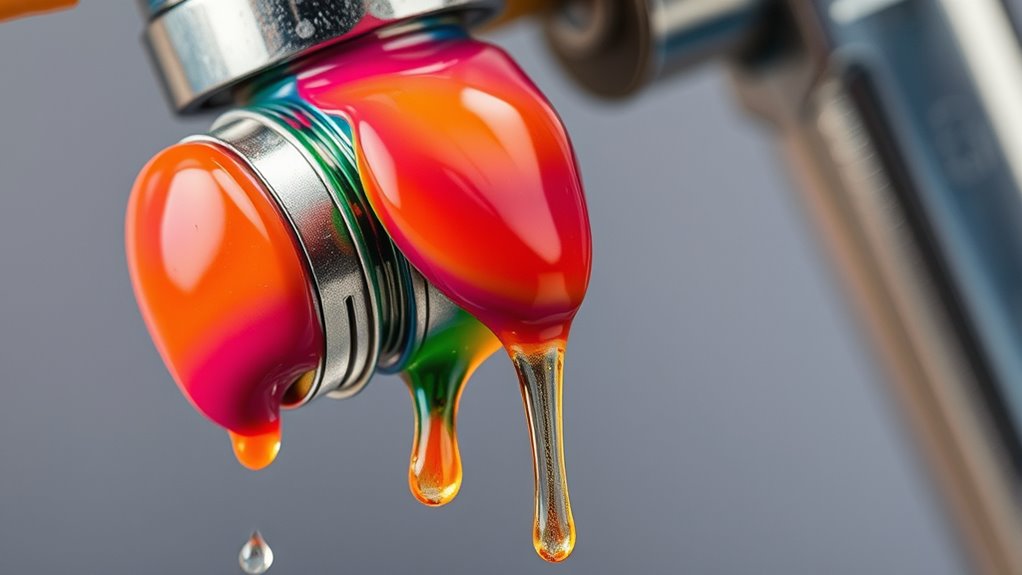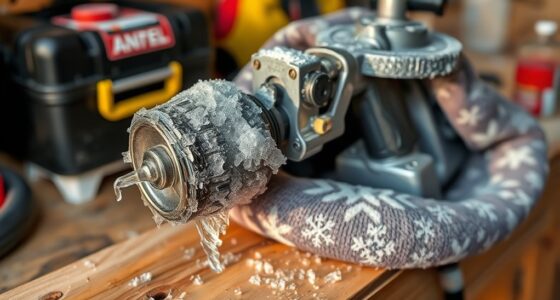If your paint is leaking from the gun or hose connections, check for loose or damaged fittings, as these often cause leaks. Tighten any loose fittings carefully, but avoid overtightening, and replace cracked or worn seals or fittings immediately. Inspect hoses for cracks or deformities and consider using thread sealant tape or compound for a better seal. To stop leaks effectively, you’ll want to guarantee all connections are secure and properly aligned—more tips follow to help you fix this quickly.
Key Takeaways
- Inspect hose fittings and connections for cracks, looseness, or damage; tighten or replace as needed.
- Use thread sealant tape or compound on threaded fittings to improve sealing.
- Ensure fittings are properly aligned and securely tightened without overtightening.
- Regularly clean the spray gun and check seals or gaskets for wear, replacing damaged parts.
- Test internal components like the needle and nozzle for damage or misalignment if leaks persist.

If you notice paint leaking from your spray gun or hose connections, it can be frustrating and messy. This issue often points to problems with hose fittings or inadequate spray gun maintenance. Leaks not only waste paint but can also cause uneven application and damage to your equipment. To fix this, start by inspecting the hose fittings carefully. Sometimes, the fittings may be loose, cracked, or improperly sealed, which allows paint to escape. Tightening or replacing damaged fittings can usually resolve the leak. Make sure to use the correct size and type of fittings specified by your spray gun manufacturer to guarantee a proper seal and prevent future leaks.
Inspect hose fittings for cracks or looseness to prevent paint leaks and ensure proper seal.
Proper spray gun maintenance is essential in preventing leaks and guaranteeing ideal performance. Regularly clean your spray gun, especially around the nozzle, seals, and connections, to remove any build-up of dried paint or debris that can compromise the seal. Check the seals and gaskets periodically for signs of wear or cracking; replace them promptly if needed. Proper lubrication of moving parts also helps maintain a good seal and prevents leaks caused by worn components. When reassembling your spray gun after cleaning, tighten all fittings and connections securely but avoid overtightening, which can damage threads or fittings and cause leaks.
Pay close attention to the hose connections during spray gun maintenance. Use thread sealant tape or thread sealant compound on threaded fittings to enhance sealing and reduce the risk of leaks. When attaching hoses, ensure they are securely connected and that the fittings are properly aligned. If you notice any cracks or deformities in the hose or fittings, replace them immediately. Using hoses and fittings designed for your specific spray system ensures compatibility and a better seal, reducing the chance of paint leaking during operation. Additionally, understanding the importance of proper installation practices can greatly reduce the likelihood of leaks and enhance the longevity of your equipment.
If leaks persist despite your efforts, consider testing your spray gun for internal issues. Sometimes, internal components like the needle or nozzle might be damaged or misaligned, causing paint to leak from connections or the spray pattern. Carefully disassemble your spray gun following the manufacturer’s instructions and check for damage. Replacing worn or damaged parts can often eliminate leaks caused by internal defects. Remember, taking the time for routine spray gun maintenance and paying attention to hose fittings can greatly extend the life of your equipment and improve your painting results. Proper care and inspection are the keys to keeping your spray system leak-free and functioning smoothly.
Frequently Asked Questions
Can Using Different Types of Paint Cause Leaks?
Yes, using different types of paint can cause leaks if you don’t consider paint compatibility and hose material. Some paints are more viscous or contain solvents that may degrade hose seals or fittings, leading to leaks. Always check that your paint is compatible with your equipment’s hose material, and verify your connections are tight and suitable for the specific paint you’re using to prevent leaks and maintain ideal performance.
How Often Should Connections Be Checked for Leaks?
You should check your connections for leaks before each use and regularly during projects to guarantee leak prevention. Conduct connection inspections at least daily or after any downtime to catch issues early. Look for signs of looseness, cracks, or drips, and tighten fittings as needed. Consistent inspection helps maintain a safe work environment and prevents paint waste or damage caused by leaks. Staying vigilant keeps your equipment functioning smoothly.
Are There Specific Tools to Prevent Hose Leaks?
Yes, you can use hose clamps and sealing tapes to prevent hose leaks. Hose clamps secure connections tightly, reducing the risk of leaks, while sealing tapes create a waterproof seal around fittings. When installing or maintaining your hoses, guarantee clamps are tight and wrap sealing tapes properly. These tools are simple, effective solutions to keep your connections secure and leak-free, saving you time and effort during your projects.
What Safety Precautions Are Necessary When Fixing Leaks?
When fixing leaks, you should always wear personal protective gear like gloves and goggles to prevent paint or solvent exposure. Verify chemical compatibility of your tools and repair materials to avoid reactions or damage. Work in a well-ventilated area, and turn off the equipment before making repairs. Follow safety guidelines closely, and handle all parts carefully to prevent further leaks or accidents.
Do Professional Repairs Differ From DIY Solutions?
Think of fixing leaks like repairing a delicate clock; professionals use precise tools and techniques to guarantee lasting results, avoiding DIY pitfalls. You might save money, but without proper skills, you risk worsening the problem or causing damage. Professional repairs involve specialized equipment, experience, and safety measures that amateurs often overlook. So, when it’s about long-term solutions and safety, trusting a pro keeps your project ticking smoothly.
Conclusion
To fix paint leaking from gun or hose connections, always check for loose fittings and wear. Tighten connections carefully, and replace any worn-out washers or seals, just like a seasoned craftsman from the days of yore would do in his workshop. Remember, a little maintenance now prevents a mess later. So, don’t be a dawdler—keep your equipment in tip-top shape, and your painting projects will turn out as smooth as a silk tapestry.
Franz came aboard the Paint Sprayer Zone team with a background in both journalism and home renovation. His articulate writing style, combined with a passion for DIY projects, makes him an invaluable asset. Franz has a knack for breaking down technical jargon into easy-to-understand content, ensuring that even the most novice of readers can grasp the complexities of paint sprayers.










